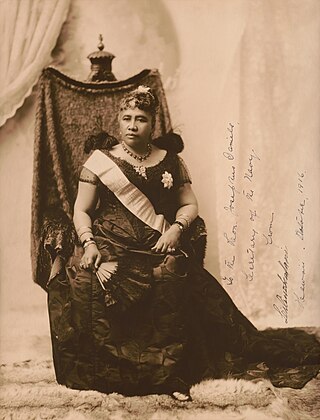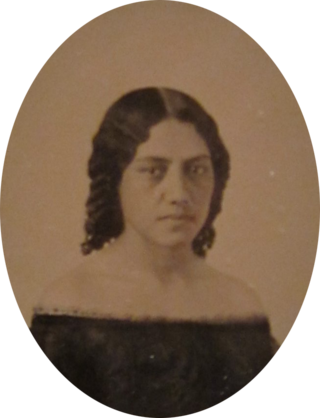Related Research Articles

Hawaii is an island state in the Western region of the United States, about 2,000 miles (3,200 km) from the U.S. mainland in the Pacific Ocean. It is the only state outside North America which is an archipelago, and the only one in the tropics.

Kamehameha I, also known as Kamehameha the Great, was the conqueror and first ruler of the Kingdom of Hawaii. The state of Hawaii gave a statue of him to the National Statuary Hall Collection in Washington, D.C., as one of two statues it is entitled to install there.

Liliʻuokalani was the only queen regnant and the last sovereign monarch of the Hawaiian Kingdom, ruling from January 29, 1891, until the overthrow of the Hawaiian Kingdom on January 17, 1893. The composer of "Aloha ʻOe" and numerous other works, she wrote her autobiography Hawaiʻi's Story by Hawaiʻi's Queen during her imprisonment following the overthrow.
The history of Hawaii describes the era of human settlements in the Hawaiian Islands. The islands were first settled by Polynesians sometime between 1000 and 1200 AD forming the modern population of Native Hawaiians. Hawaiian civilization was isolated from the rest of the world for at least 500 years.

Bernice Pauahi Pākī Bishop KGCOK RoK was an aliʻi (noble) of the Royal Family of the Kingdom of Hawaii and a well known philanthropist. At her death, her estate was the largest private landownership in the Hawaiian Islands, comprising approximately 9% of Hawaii's total area. The revenues from these lands are used to operate the Kamehameha Schools, which were established in 1887 according to Pauahi's will. Pauahi was married to businessman and philanthropist Charles Reed Bishop.

Kalākaua, sometimes called The Merrie Monarch, was the last king and penultimate monarch of the Kingdom of Hawaiʻi, reigning from February 12, 1874, until his death in 1891. Succeeding Lunalilo, he was elected to the vacant throne of Hawaiʻi against Queen Emma. Kalākaua had a convivial personality and enjoyed entertaining guests with his singing and ukulele playing. At his coronation and his birthday jubilee, the hula, which had hitherto been banned in public in the kingdom, became a celebration of Hawaiian culture.

Lunalilo was the sixth monarch of the Kingdom of Hawaii from his election on January 8, 1873, until his death a year later.

Kamehameha IV, reigned as the fourth monarch of Hawaii under the title Ke Aliʻi o ko Hawaiʻi Pae ʻAina of the Kingdom of Hawaii from January 11, 1855, to November 30, 1863.

Kamehameha III was the third king of the Kingdom of Hawaii from 1825 to 1854. His full Hawaiian name was Keaweaweʻula Kīwalaʻō Kauikeaouli Kaleiopapa and then lengthened to Keaweaweʻula Kīwalaʻō Kauikeaouli Kaleiopapa Kalani Waiakua Kalanikau Iokikilo Kīwalaʻō i ke kapu Kamehameha when he ascended the throne.

Kamehameha V, reigned as the fifth monarch of the Kingdom of Hawaiʻi from 1863 to 1872. His motto was "Onipaʻa": immovable, firm, steadfast or determined; he worked diligently for his people and kingdom and was described as the last great traditional chief.
The aliʻi were the traditional nobility of the Hawaiian islands. They were part of a hereditary line of rulers, the noho aliʻi.

Colonel Curtis Piʻehu Iaukea served as a court official, army officer and diplomat of the Kingdom of Hawaii. He later became an influential official for the subsequent regimes of the Provisional Government and the Republic and the Territory of Hawaii.

The Hawaiian sovereignty movement is a grassroots political and cultural campaign to reestablish an autonomous or independent nation or kingdom of Hawaii out of a desire for sovereignty, self-determination, and self-governance. Some groups also advocate some form of redress from the United States for its 1893 overthrow of Queen Liliʻuokalani, and for what is described as a prolonged military occupation beginning with the 1898 annexation. The movement generally views both the overthrow and annexation as illegal. Palmyra Atoll and Sikaiana were annexed by the Kingdom in the 1860s, and the movement regards them as under illegal occupation along with the Hawaiian Islands. The Apology Resolution the United States Congress passed in 1993 acknowledged that the overthrow of the Hawaiian Kingdom was an illegal act.
The Hawaiian Independent Party, was a political party active in Hawaii from 1900 to 1912, during which time Hawaii was controlled by the United States and administered as the Territory of Hawaii. The Party was established by Robert Wilcox, immediately after the United States annexed the Hawaiian Islands with the Newlands Resolution in 1898 and established the Territory of Hawaii with the Hawaiian Organic Act in 1900. The party was formed to represent and advocate for the rights and interests of Native Hawaiians, many of whom were then inclined to believe that both the Democratic Party of Hawai‘i and Hawai‘i Republican Party were yet incapable of representing them.

Alexis Bachelot, SS.CC., was a Catholic priest best known for his tenure as the first Prefect Apostolic of the Sandwich Islands. In that role, he led the first permanent Catholic mission to the Kingdom of Hawaii. Bachelot was raised in France, where he attended the Irish College in Paris, and was ordained a priest in 1820. He led the first Catholic mission to Hawaii, arriving in 1827. Although he had expected the approval of then Hawaiian King Kamehameha II, he learned upon arrival that Kamehameha II had died and a new government that was hostile towards Catholic missionaries had been installed. Bachelot, however, was able to convert a small group of Hawaiians and quietly minister to them for four years before being deported in 1831 on the orders of Kaʻahumanu, the Kuhina Nui of Hawaii.

The overthrow of the Hawaiian Kingdom was a coup d'état against Queen Liliʻuokalani, which took place on January 17, 1893, on the island of Oʻahu and led by the Committee of Safety, composed of seven foreign residents and six Hawaiian Kingdom subjects of American descent in Honolulu. The Committee prevailed upon American minister John L. Stevens to call in the U.S. Marines to protect the national interest of the United States of America. The insurgents established the Republic of Hawaii, but their ultimate goal was the annexation of the islands to the United States, which occurred in 1898.

Elizabeth Kekaʻaniau Laʻanui Pratt, full name Elizabeth Kekaʻaniauokalani Kalaninuiohilaukapu Kekaikuihala Laʻanui Pratt, was a Hawaiian high chiefess (aliʻi) and great-grandniece of Kamehameha I, being a great-granddaughter of Kalokuokamaile, the older brother of Kamehameha I, founder of the Kingdom of Hawaii. She was the daughter of Gideon Peleʻioholani Laʻanui and Theresa Owana Kaheiheimalie Rives.

Charles Kanaʻina, was an aliʻi of the Kingdom of Hawaii, prince consort of Kuhina Nui, Kaʻahumanu III and father of William Charles Lunalilo, the 6th monarch of the Kamehameha Dynasty. Kanaʻina was a descendant of several figures from ancient Hawaiian history, including Liloa, Hakau and Umi-a-Liloa of Hawaiʻi Island as well as Piilani of Maui. He served on both the Privy Counsel and in the House of Nobles. He was named after his uncle Kanaʻina, a name that means "The conquering" in the Hawaiian Language. This uncle greeted Captain James Cook in 1778 and confronted the navigator before he was killed.

The Hawaiian Kingdom, or Kingdom of Hawaiʻi, was a sovereign state located in the Hawaiian Islands in the 19th century. The country was formed in 1795, when warrior chief Kamehameha the Great, of the independent island of Hawaiʻi, conquered the independent islands of Oʻahu, Maui, Molokaʻi, and Lānaʻi, and unified them under one government. In 1810, the Hawaiian archipelago became unified when Kauaʻi and Niʻihau voluntarily joined the Hawaiian Kingdom. Two major dynastic families ruled the kingdom: the House of Kamehameha and the House of Kalākaua.

Hawaii–Tahiti relations refers to the historical relationship between the independent Hawaiian Kingdom and the Kingdom of Tahiti. Relations included one treaty, proposed marriage alliances and exchanges of trade and diplomatic representatives from the early 1800s to 1880.
References
- ↑ Curtis Piʻehu Iʻaukea; Lorna Kahilipuaokalani Iʻaukea Watson (May 1988). By royal command: the official life and personal reminiscences of Colonel Curtis Piʾehu Iaukea at the court of Hawaii's rulers. Hui Hanai. p. 144. ISBN 978-0-9616738-6-4.
- ↑ Lydia K Kualapai (2001). Cast in Print: The Nineteenth-century Hawaiian Imaginary. University of Nebraska--Lincoln. p. 146.
- ↑ George Thomas Kurian; Mark A. Lamport (10 November 2016). Encyclopedia of Christianity in the United States. Rowman & Littlefield Publishers. p. 494. ISBN 978-1-4422-4432-0.
- ↑ Robert Oaks (1 November 2003). Hawai'i: A History of the Big Island. Arcadia Publishing. p. 43. ISBN 978-0-7385-2436-8.
- ↑ Sally Engle Merry (2000). Colonizing Hawai'i: The Cultural Power of Law. Princeton University Press. p. 45. ISBN 0-691-00932-5.
- ↑ Joaquim Francisco Freitas (1930). Portuguese-Hawaiian Memories. J.F. Freitas. p. 67.
- ↑ Donald Dalton Johnson; Gary Dean Best; Lenore S. Johnson (1995). The United States in the Pacific: Private Interests and Public Policies, 1784-1899. Greenwood Publishing Group. p. 85. ISBN 978-0-275-95055-2.
- ↑ Richard T. Schaefer (20 March 2008). Encyclopedia of Race, Ethnicity, and Society. SAGE Publications. p. 670. ISBN 978-1-4522-6586-5.
- ↑ Wilder, Royal Gould; Pierson, Delavan Leonard; Pierson, Arthur Tappan; Sherwood, James Manning (1900). The Missionary Review of the World. C.S. Robinson & Company, printers. p. 387.
- ↑ United States. Congress. Senate. Committee on Indian Affairs (1993- ) (2003). Policy of the United States Regarding Relationship with Native Hawaiians and to Provide a Process for the Recognition by the United States of the Native Hawaiian Governing Entity: Hearing Before the Committee on Indian Affairs, United States Senate, One Hundred Eighth Congress, First Session on S. 344, Expressing the Policy of the United States Regarding the United States Relationship with Native Hawaiians and to Provide a Process for the Recognition by the United States of the Native Hawaiian Governing Entity, February 25, 2003, Washington, DC. U.S. Government Printing Office. pp. 220–230publisher=U.S. Government Printing Office. ISBN 978-0-16-070381-2.
{{cite book}}: CS1 maint: numeric names: authors list (link) - 1 2 3 James Bradley (24 November 2009). The Imperial Cruise: A Secret History of Empire and War . Little, Brown. p. 140. ISBN 978-0-316-03966-6.